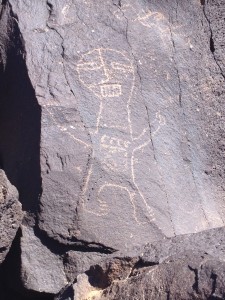As we have journeyed, we have been following a trail of petroglyphs across northern New Mexico, admiring the stunning quality of some, puzzling over others. We are fascinated by what wisdom they may have been communicating, what news they may have been sharing. We have pondered whether they are religious or spiritual illustrations (since there is more than one representation of Kokopelli and other important-looking figures), or whether they are more mundane statements such as the establishment of clan or tribal boundaries, or route markers for trade.
 As we have pondered and marveled, we have taken pictures. One day, we came back to the hotel with 287 photos to be sorted into a few keepers and many many discards. After that exercise, I casually asked George if we would have bothered to take 287 photos of graffiti, or 287 photos of initials carved in trees, or 287 photos of rocks painted in school colors by graduating seniors. Or would we have looked at any of those and seen destruction, perhaps expressed our outrage to one another at the desecration of the environment and walked away shaking our heads? We argued back and forth, playing devil’s advocate for each other and finally came down in different places.
As we have pondered and marveled, we have taken pictures. One day, we came back to the hotel with 287 photos to be sorted into a few keepers and many many discards. After that exercise, I casually asked George if we would have bothered to take 287 photos of graffiti, or 287 photos of initials carved in trees, or 287 photos of rocks painted in school colors by graduating seniors. Or would we have looked at any of those and seen destruction, perhaps expressed our outrage to one another at the desecration of the environment and walked away shaking our heads? We argued back and forth, playing devil’s advocate for each other and finally came down in different places.
For George, painting boulders with school colors is different than carving a snake on a rock (we didn’t get into whether carving the school logo on a rock would be offensive or not)…and some of that has to do with population density. In a world where whole tribes might pass like ships in the night (as might have happened in 1100 or 1300 CE), a message on a rock might be the only way to communicate important information. On the other hand, a paper graduation announcement mailed to family and friends in a literate, densely populated society is more appropriate, especially where there may be 15 or 20 high schools in a 30 mile radius and, thus, the potential for garish and clashing rock walls everywhere you look.
For me, it isn’t quite that clear. And I think part of my uncertainty comes from my love for the contemporary native art all around us as we travel. There is considerable argument in the native community about appropriate technique and style. The central question is whether contemporary weavers, potters, and silversmiths should stay as close as possible to their roots, or are they free to develop new designs and interpret old ones in new ways? Several famous and well-respected native artists have argued persuasively that to restrict artistic expression is the equivalent of embalming the culture. [As an aside, I have heard similar arguments in Wales and Ireland around language, poetry, and music.]
As we looked at petroglyphs and visited a few abandoned kivas, it is clear that these images morphed radically in past generations. Even the untrained eye can see that some images are extremely minimal and others are highly complex and representational. Obviously as clans and tribes brushed against other clans and tribes, ideas or pictographs were shared and adapted just as religious stories were shared and adapted. Maybe there were similar arguments about tradition centuries ago, but however fierce the resistance, change happened.
So what makes a rock carving (petroglyph) from 1100 CE more “authentic” or artistic or valuable than one from 1894 or 1987 or 2010? Why do we admire the rock carving of a young Hopi or Zuni man or woman dead over 800 years ago, but disparage the rock carving of a young New Mexican of today? Especially since it is clear that many of the ancient petroglyphs were not intended as art, but as information no more meaningful than speed limit signs or billboards?
Perspective is a strange and wondrous thing. It can catapult us into soaring flights of creativity, or it can mire us in resistance. It can invite us to disregard valuable knowledge and tradition, or it can inspire us to cherish and retain skills on the verge of extinction. I don’t have any answers, but it seems important to keep asking the questions. Thanks for considering them with me.
–Andrea
Text © 2014, Andrea La Sonde Anastos
Photo © 2014, Immram Chara, LLC